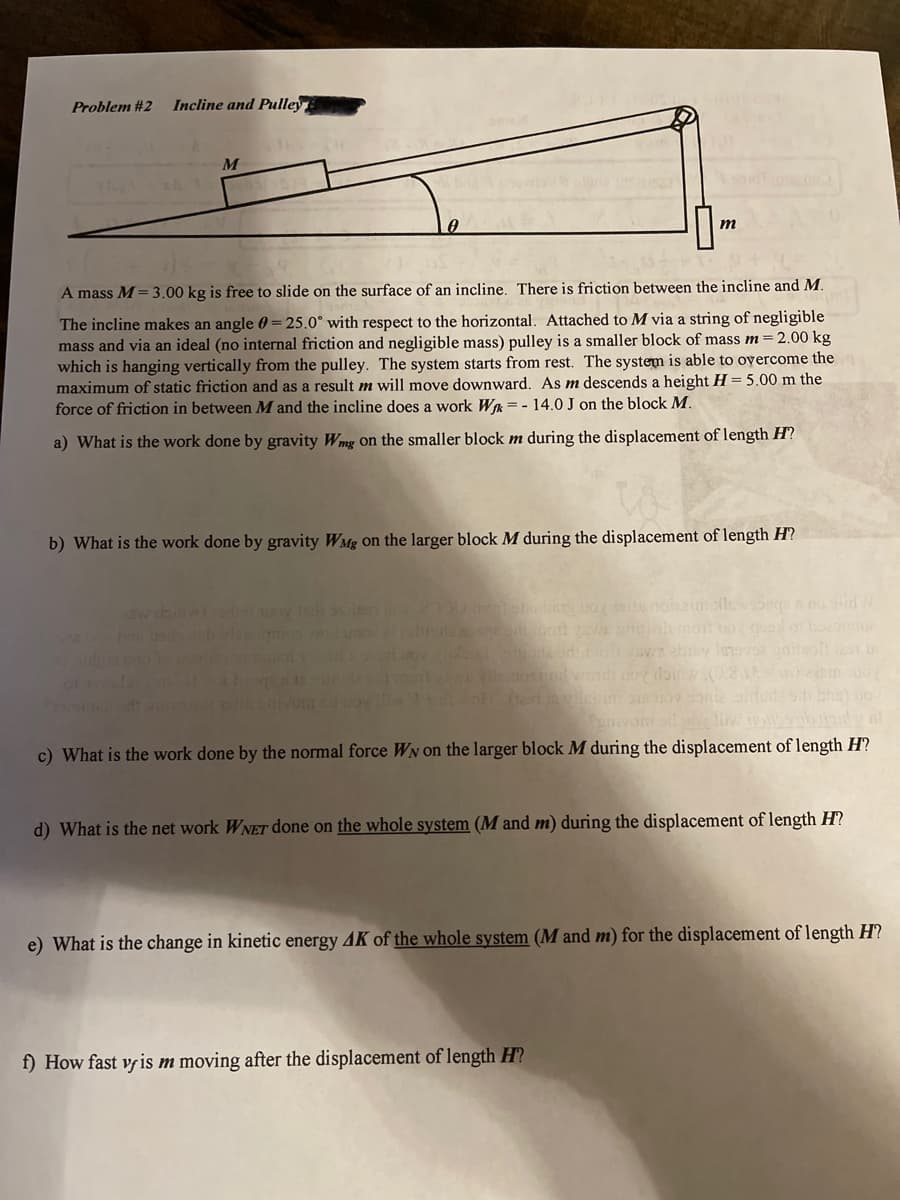Problem #2 Incline and Pulley M m A mass M = 3.00 kg is free to slide on the surface of an incline. There is friction between the incline and M. The incline makes an angle 0 = 25.0° with respect to the horizontal. Attached to M via a string of negligible mass and via an ideal (no internal friction and negligible mass) pulley is a smaller block of mass m= 2.00 kg which is hanging vertically from the pulley. The system starts from rest. The system is able to oyercome the maximum of static friction and as a result m will move downward. As m descends a height H = 5.00 m the force of friction in between M and the incline does a work W = - 14.0 J on the block M. a) What is the work done by gravity Wmg on the smaller block m during the displacement of length H? b) What is the work done by gravity WMg on the larger block M during the displacement of length H? be oilnoim wsoe idW met nos O What is the work done by the normal force WN on the larger block M during the displacement of length H?
Problem #2 Incline and Pulley M m A mass M = 3.00 kg is free to slide on the surface of an incline. There is friction between the incline and M. The incline makes an angle 0 = 25.0° with respect to the horizontal. Attached to M via a string of negligible mass and via an ideal (no internal friction and negligible mass) pulley is a smaller block of mass m= 2.00 kg which is hanging vertically from the pulley. The system starts from rest. The system is able to oyercome the maximum of static friction and as a result m will move downward. As m descends a height H = 5.00 m the force of friction in between M and the incline does a work W = - 14.0 J on the block M. a) What is the work done by gravity Wmg on the smaller block m during the displacement of length H? b) What is the work done by gravity WMg on the larger block M during the displacement of length H? be oilnoim wsoe idW met nos O What is the work done by the normal force WN on the larger block M during the displacement of length H?
College Physics
11th Edition
ISBN:9781305952300
Author:Raymond A. Serway, Chris Vuille
Publisher:Raymond A. Serway, Chris Vuille
Chapter1: Units, Trigonometry. And Vectors
Section: Chapter Questions
Problem 1CQ: Estimate the order of magnitude of the length, in meters, of each of the following; (a) a mouse, (b)...
Related questions
Question
Please answer parts a,b and c. Show all work and circle your answers. Thank you

Transcribed Image Text:Problem #2
Incline and Pulley
m
A mass M= 3.00 kg is free to slide on the surface of an incline. There is friction between the incline and M.
The incline makes an angle 0 = 25.0° with respect to the horizontal. Attached to M via a string of negligible
mass and via an ideal (no internal friction and negligible mass) pulley is a smaller block of mass m= 2.00 kg
which is hanging vertically from the pulley. The system starts from rest. The system is able to overcome the
maximum of static friction and as a result m will move downward. As m descends a height H = 5.00 m the
force of friction in between M and the incline does a work Wa = - 14.0 J on the block M.
a) What is the work done by gravity Wmg on the smaller block m during the displacement of length H?
b) What is the work done by gravity WMg on the larger block M during the displacement of length H?
wsonge no stid W
i ra o aby le
c) What is the work done by the normal force WN on the larger block M during the displacement of length H?
d) What is the net work WNET done on the whole system (M and m) during the displacement of length H?
e) What is the change in kinetic energy 4K of the whole system (M and m) for the displacement of length H?
f) How fast vyis m moving after the displacement of length H?
Expert Solution
This question has been solved!
Explore an expertly crafted, step-by-step solution for a thorough understanding of key concepts.
Step by step
Solved in 2 steps with 1 images

Knowledge Booster
Learn more about
Need a deep-dive on the concept behind this application? Look no further. Learn more about this topic, physics and related others by exploring similar questions and additional content below.Recommended textbooks for you

College Physics
Physics
ISBN:
9781305952300
Author:
Raymond A. Serway, Chris Vuille
Publisher:
Cengage Learning

University Physics (14th Edition)
Physics
ISBN:
9780133969290
Author:
Hugh D. Young, Roger A. Freedman
Publisher:
PEARSON

Introduction To Quantum Mechanics
Physics
ISBN:
9781107189638
Author:
Griffiths, David J., Schroeter, Darrell F.
Publisher:
Cambridge University Press

College Physics
Physics
ISBN:
9781305952300
Author:
Raymond A. Serway, Chris Vuille
Publisher:
Cengage Learning

University Physics (14th Edition)
Physics
ISBN:
9780133969290
Author:
Hugh D. Young, Roger A. Freedman
Publisher:
PEARSON

Introduction To Quantum Mechanics
Physics
ISBN:
9781107189638
Author:
Griffiths, David J., Schroeter, Darrell F.
Publisher:
Cambridge University Press

Physics for Scientists and Engineers
Physics
ISBN:
9781337553278
Author:
Raymond A. Serway, John W. Jewett
Publisher:
Cengage Learning

Lecture- Tutorials for Introductory Astronomy
Physics
ISBN:
9780321820464
Author:
Edward E. Prather, Tim P. Slater, Jeff P. Adams, Gina Brissenden
Publisher:
Addison-Wesley

College Physics: A Strategic Approach (4th Editio…
Physics
ISBN:
9780134609034
Author:
Randall D. Knight (Professor Emeritus), Brian Jones, Stuart Field
Publisher:
PEARSON